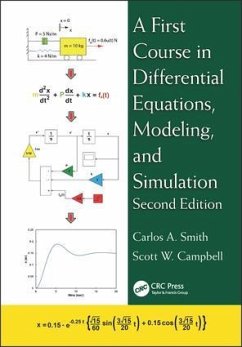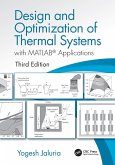A First Course in Differential Equations, Modeling, and Simulation shows how differential equations arise from applying basic physical principles and experimental observations to engineering systems. Avoiding overly theoretical explanations, the textbook also discusses classical and Laplace transform methods for obtaining the analytical solution of differential equations. In addition, the authors explain how to solve sets of differential equations where analytical solutions cannot easily be obtained.
Incorporating valuable suggestions from mathematicians and mathematics professors, the Second Edition:
Expands the chapter on classical solutions of ordinary linear differential equations to include additional methodsIncreases coverage of response of first- and second-order systems to a full, stand-alone chapter to emphasize its importanceIncludes new examples of applications related to chemical reactions, environmental engineering, biomedical engineering, and biotechnologyContains new exercises that can be used as projects and answers to many of the end-of-chapter problemsFeatures new end-of-chapter problems and updates throughout
Thus, A First Course in Differential Equations, Modeling, and Simulation, Second Edition provides students with a practical understanding of how to apply differential equations in modern engineering and science.
Incorporating valuable suggestions from mathematicians and mathematics professors, the Second Edition:
Expands the chapter on classical solutions of ordinary linear differential equations to include additional methodsIncreases coverage of response of first- and second-order systems to a full, stand-alone chapter to emphasize its importanceIncludes new examples of applications related to chemical reactions, environmental engineering, biomedical engineering, and biotechnologyContains new exercises that can be used as projects and answers to many of the end-of-chapter problemsFeatures new end-of-chapter problems and updates throughout
Thus, A First Course in Differential Equations, Modeling, and Simulation, Second Edition provides students with a practical understanding of how to apply differential equations in modern engineering and science.
"This book is well suited for those with an introductory 'survey' course which looks at typical problems in many different engineering fields at a lower-division level. This book is excellent in showing the commonality of the application of differential equations across many engineering disciplines. The authors have an EXCELLENT sense of the appropriate level of coverage for the lower-division student-i.e., 'just enough words.' Short chapters and clear writing make the text very understandable, enabling students to grasp what's important and to apply the concepts to problem solutions simply through reading! One of the best attributes of the book is its length-which is, SHORT. I don't feel guilty insisting that the students bring the book to class. The additional systems coverage, examples, and end-of-chapter problems add to an already good (excellent) book. ... I love this book for my sophomore-level class in which we focus on the systems. Both the amount of material covered and the level of presentation are perfect for lower-division students who can be easily overwhelmed by excessive detail. Because of this level, I can (and do) use this book as the primary resource for 'out-of-class' preparation students have to do in advance for the daily classroom problem solving work in a flipped classroom environment. No video lectures are needed, because the book is great!"
-Susan Schneider, Marquette University, Milwaukee, Wisconsin, USA
"The greatest strength of the book is that it combines mathematical concepts that younger engineers and scientists often find difficult to understand, and wraps the concepts up into practical examples. In fact, it camouflages mathematics into real-world science and engineering problems. Students learn the mathematics without knowing they are learning mathematics at all. Problem solving is at the heart of science and engineering, and knowing how to apply the underlying mathematics is crucial to solving many problems. This book seamlessly integrates the math with the end-point solutions. ... Often mathematical concepts are presented to students in an abstract fashion, which hinders the learning process. This text provides a simple, clear, and introductory synthesis of differential equation mathematics with realistic science and engineering problems, and provides a framework for students to learn mathematics' underlying problem solving with the emphasis being on how math can help solve problems."
-Dr. Edward Waller, University of Ontario Institute of Technology, Oshawa, Canada
"The authors appear to have thought carefully about how best to organize the content to make it understandable to students. The incremental development of mathematical methods, well-motivated by their application to physical systems, is both accessible and engaging. The new modeling and simulation degree programs that are emerging at forward-thinking universities around the country often include a required course on physics-based modeling. This volume would make an excellent choice as a textbook for such a course."
-Mikel D. Petty, Ph.D., University of Alabama in Huntsville, USA
"This book really highlights the utility of ordinary differential equations in physics and engineering. The approach taken in this book should provide students from those disciplines with an excellent motivation to study differential equations. Furthermore, students will gain a deep understanding of how to turn an engineering diagram or free-body diagram into a differential equation."
-Jason M. Graham, University of Scranton, Pennsylvania, USA
"This is a great differential equations book for non-engineering majors. It has many real problems that you cannot find in other books. I think it can be a perfect book for chemistry or biology majors."
-Dr. Linus Yu, University of Arkansas - Fort Smith, USA
"The book deals with a variety of differential equations from the point of view of concrete problems arising in basic models of physics, engineering, and other sciences. After a wide range of possible model differential equations from different subject areas is reviewed, elements of the general theory are introduced. This is done by presenting different methods for finding their solutions. The emphasis of the book is on reviewing concrete methods for solving different types of differential equations, rather than on presenting strict mathematical proofs. As such, it appears ideally suited for the demands of concrete applications. The exposition is very well supplemented by numerous examples, testing questions, discussions, and solutions."
-Professor Michael Ruzhansky, Imperial College London, UK
-Susan Schneider, Marquette University, Milwaukee, Wisconsin, USA
"The greatest strength of the book is that it combines mathematical concepts that younger engineers and scientists often find difficult to understand, and wraps the concepts up into practical examples. In fact, it camouflages mathematics into real-world science and engineering problems. Students learn the mathematics without knowing they are learning mathematics at all. Problem solving is at the heart of science and engineering, and knowing how to apply the underlying mathematics is crucial to solving many problems. This book seamlessly integrates the math with the end-point solutions. ... Often mathematical concepts are presented to students in an abstract fashion, which hinders the learning process. This text provides a simple, clear, and introductory synthesis of differential equation mathematics with realistic science and engineering problems, and provides a framework for students to learn mathematics' underlying problem solving with the emphasis being on how math can help solve problems."
-Dr. Edward Waller, University of Ontario Institute of Technology, Oshawa, Canada
"The authors appear to have thought carefully about how best to organize the content to make it understandable to students. The incremental development of mathematical methods, well-motivated by their application to physical systems, is both accessible and engaging. The new modeling and simulation degree programs that are emerging at forward-thinking universities around the country often include a required course on physics-based modeling. This volume would make an excellent choice as a textbook for such a course."
-Mikel D. Petty, Ph.D., University of Alabama in Huntsville, USA
"This book really highlights the utility of ordinary differential equations in physics and engineering. The approach taken in this book should provide students from those disciplines with an excellent motivation to study differential equations. Furthermore, students will gain a deep understanding of how to turn an engineering diagram or free-body diagram into a differential equation."
-Jason M. Graham, University of Scranton, Pennsylvania, USA
"This is a great differential equations book for non-engineering majors. It has many real problems that you cannot find in other books. I think it can be a perfect book for chemistry or biology majors."
-Dr. Linus Yu, University of Arkansas - Fort Smith, USA
"The book deals with a variety of differential equations from the point of view of concrete problems arising in basic models of physics, engineering, and other sciences. After a wide range of possible model differential equations from different subject areas is reviewed, elements of the general theory are introduced. This is done by presenting different methods for finding their solutions. The emphasis of the book is on reviewing concrete methods for solving different types of differential equations, rather than on presenting strict mathematical proofs. As such, it appears ideally suited for the demands of concrete applications. The exposition is very well supplemented by numerous examples, testing questions, discussions, and solutions."
-Professor Michael Ruzhansky, Imperial College London, UK








